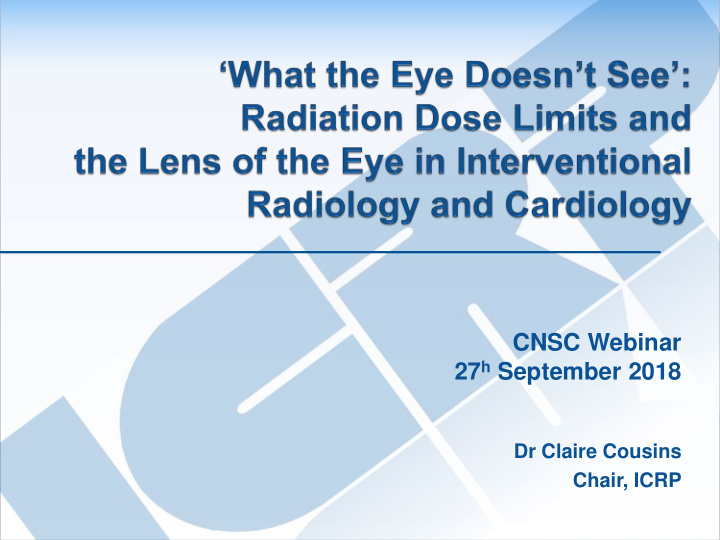



CNSC Webinar 27 h September 2018 Dr Claire Cousins Chair, ICRP
No conflict of interest to disclose with respect to this presentation
In 2011, ICRP issued a statement regarding the lens of the eye: ‘For occupational exposure in planned exposure situations, the Commission now recommends an equivalent dose limit for the lens of the eye of 20 mSv/year, averaged over defined periods of 5 years, with no single year exceeding 50 mSv.’
Medical workers perform complex fluoroscopically guided procedures in interventional radiology and cardiology They may receive some of the highest occupational exposures (scattered radiation) If appropriate protection is not worn, interventionalists could receive doses to the eye that exceed the new dose limit
Ophthalmology studies have shown a 4-5x incidence of lens opacities in interventionalists vs controls (RELID study) Some operators, particularly those with a high case load, concerned the lower dose limit may constitute a possible threat to working medical practice
Barnard et al, BJR, 2016
3 large hospitals UK, cardiology procedures 61 participants, lead glasses worn by 9 2/61 projected eye dose close to 20 mSv Ainsbury et al, J.Radiol.Prot, 2013 204 interventionalists, 8 hospitals 6 hospitals at least one member of staff who exceeded an equivalent of the 20 mSv dose Martin et al, J.Radiol.Prot, 2013
Additional lead glasses £1,800,000 Ceiling suspended lead shields £1,600,000 Raising awareness new limit £164,500 Revising risk assessments £126,000 Medicals for newly classified staff £94,000 Dosimetry service approvals £49,000 Total approx. £4 million HSE, UK, 2013
HSE, UK, 2013
Use protection equipment Comply with wearing dosemeters Important interventionalists receive regular and appropriate education and training in radiological protection
Ceiling suspended lead acrylic shields Protective eyewear Shielding pads and drapes
Reported dose reduction factors typically 2-10 Depends on effective positioning More difficult to use in lateral and oblique projections Require continual repositioning
Frontal protection, (0.75mm Pb, 65g) Frontal and side protection, (0.75mm Pb, 110g) My first lead glasses, >25 years ago, 75g
Weight and comfort of glasses Corrective prescription lenses Lens size and lead equivalence Close fit to facial contours important Conservative approach, dose reduction factor with glasses of 2
Eye doses can be assessed from a dosemeter placed over the lead apron at the collar or level of the neck Headband dosemeter with the sensor adjacent to the temple closest to the x-ray tube Dosemeter attached to the glasses Dosemeter inside the glasses (3 dosemeters) Compliance in the wearing of dosemeters important and needs to be practical
New dosemeter developed and tested within the ORAMED project EYE-D™ monitors H p(3) – personal dose equivalent at a depth of 3mm
European study of interventional radiology and cardiology >1300 eye dose measurements Interventional radiology: No protection 1% Lead apron alone 12% Lead apron + collar 62% Apron, collar + lead glasses 25%
Highest eye lens doses for embolisations, 60µSv/procedure In IR, eye lens doses reduced by: Lead glasses factor 3 to 6 Ceiling shield factor 3 to 8 for embolisations
Pub 139: Occupational RP in Interventional Procedures Pub 121: RP in Paediatric Diagnostic and Interventional Radiology Pub 120: RP in Cardiology Pub 117: RP in Fluoroscopically Guided Procedures outside the Imaging Department Pub 113: Education and Training in RP for Diagnostic and Interventional Procedures
Compliance of interventionalists with the revised ICRP dose limit for the lens of the eye should be possible if appropriate dosimetry and protection are applied This will require behavioural change and periodic education and training of medical workers
Eye lens dose monitoring techniques need to be refined and standardised to give accurate results Protective devices should be evaluated and designs both updated and improved to meet the needs of the future Protective devices should be worn for all procedures and good practices in the use of ionising radiation adopted
Barnard et al, BJR, 2016
www.icrp.org
Recommend
More recommend